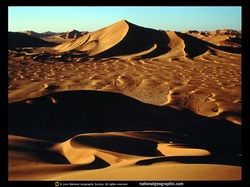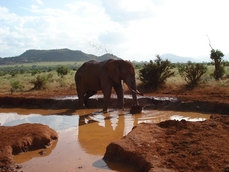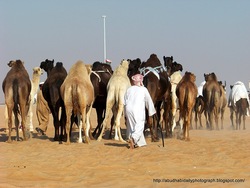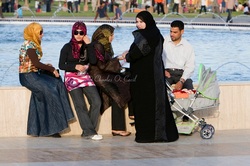North Africa and Southwest Asia!
There are 20 countries in this region
These countries consist of: Saudi Arabia, Sudan, Oman, United Arab, Emirates, Iran, Iraq, Turkey, Syria, Libya, Algeria, Morocco, Egypt, Tunisia, Lebanon, Yemen,Israel, Qatar, Bahrain, and Kuwait.
These countries consist of: Saudi Arabia, Sudan, Oman, United Arab, Emirates, Iran, Iraq, Turkey, Syria, Libya, Algeria, Morocco, Egypt, Tunisia, Lebanon, Yemen,Israel, Qatar, Bahrain, and Kuwait.
Physical Features:

Great Desert Region of Rub'al Khali
Desert and steppe lands cover most of the land of North Africa and Saudi Arabia.
Great Desert of Rub'al Khali: This is also a big desert region like the Sahara desert. It virtually has very little to no vegetation what so ever. The sand dunes are the worlds largest because of the strong winds, some of the dunes reaching up to more than 2000 feet in height. In the desert temps vary drastically between the daytime and nighttime.
African Plate/Arabian Plate: A rift formed by these two tectonic plates separates Africa and Southwest Asia. The African and Arabian tectonic plates are essentially moving away from each other. The rift which began to form over 12 million years ago is now occupied by the Red Sea. The Arabian Peninsula lies to the east of the rift. There the mountains are bordering the rift in the southwestern corner which can rise up to 12,000 feet.
Nile/ Euphrates/ Tigris Rivers: These are the three major rivers running through North Africa and Southwest Asia. The Nile river flows north, and the Tigris and Euphrates rivers begin in the mountains of Turkey and flow southeast. The Jordan river is a fourth and smaller river in the area as well. These rivers are part of the religions and sacred lands of the regions.
Great Desert of Rub'al Khali: This is also a big desert region like the Sahara desert. It virtually has very little to no vegetation what so ever. The sand dunes are the worlds largest because of the strong winds, some of the dunes reaching up to more than 2000 feet in height. In the desert temps vary drastically between the daytime and nighttime.
African Plate/Arabian Plate: A rift formed by these two tectonic plates separates Africa and Southwest Asia. The African and Arabian tectonic plates are essentially moving away from each other. The rift which began to form over 12 million years ago is now occupied by the Red Sea. The Arabian Peninsula lies to the east of the rift. There the mountains are bordering the rift in the southwestern corner which can rise up to 12,000 feet.
Nile/ Euphrates/ Tigris Rivers: These are the three major rivers running through North Africa and Southwest Asia. The Nile river flows north, and the Tigris and Euphrates rivers begin in the mountains of Turkey and flow southeast. The Jordan river is a fourth and smaller river in the area as well. These rivers are part of the religions and sacred lands of the regions.
Landforms:
Atlas Mountains:
This mountain range is particularly in Northwestern Africa. They
stretch all the way from Morocco on the Atlantic to Tunis on the
Mediterranean Sea.
The Great Sahara Desert: This desert is found behind the Atlas Mountain range to the south east. The Sahara's size and southerly location make it a particularly desert region.
Arabian Peninsula: (lies to the east of the rift discussed up in physical features under the African and Arabian tectonic plates)
The Great Sahara Desert: This desert is found behind the Atlas Mountain range to the south east. The Sahara's size and southerly location make it a particularly desert region.
Arabian Peninsula: (lies to the east of the rift discussed up in physical features under the African and Arabian tectonic plates)
Climates related to landforms:
The
Atlas mountains block and lift moisture-laden winds from the Atlantic,
creating conditions that lead to rainfall of more than 50 inches a year
in some places in this region. There is also a sufficient amount of
snowfall in this mountain range due to the amount of precipitation along
with the cooler air in the higher elevations of the Atlas Mountains.
In some places here temperatures can reach 130 degrees Fahrenheit in the shade at midday. Where as night time temperatures can drop quickly to below freezing. Rainfall here falls very rarely due to the position the desert is with the mountain range. The mountains take all the moisture leaving nothing but a vast open dry arid desert. Rainfall here is also very unpredictable when it does so happen to occur.
The precipitation the rift captures from the moisture-laden monsoon winds crossing Central Africa is the primary source of rain for the entire peninsula.
In some places here temperatures can reach 130 degrees Fahrenheit in the shade at midday. Where as night time temperatures can drop quickly to below freezing. Rainfall here falls very rarely due to the position the desert is with the mountain range. The mountains take all the moisture leaving nothing but a vast open dry arid desert. Rainfall here is also very unpredictable when it does so happen to occur.
The precipitation the rift captures from the moisture-laden monsoon winds crossing Central Africa is the primary source of rain for the entire peninsula.
Climates (in general):

Tunis.
No other region in the world is as pervasively dry as North Africa and
Southwest Asia. Land forms and Climate are very closely related in this
region.
The typical climate in North Africa and Southwest Asia is dry and hot in the vast stretches of relatively low, flat land. There is typically a bit of moisture where the mountain ranges are that capture the moisture and rainfall. Temperatures range from over 130 degree's Fahrenheit in the shade on a sunny day, and can drop quickly to below freezing in the night time. In the uplands of this region there is typically enough rainfall to nature grass, some trees, and limited agriculture.
The typical climate in North Africa and Southwest Asia is dry and hot in the vast stretches of relatively low, flat land. There is typically a bit of moisture where the mountain ranges are that capture the moisture and rainfall. Temperatures range from over 130 degree's Fahrenheit in the shade on a sunny day, and can drop quickly to below freezing in the night time. In the uplands of this region there is typically enough rainfall to nature grass, some trees, and limited agriculture.
Agriculture

Herding Camels.
Crops in this region until recently, have been confined to the coastal zones, river valleys, and areas with in the Mediterranean climate.
Some crops that are raised in the Nile River Valley of Sudan and Egypt are: Grains, Cotton, Rice, Corn, Peanuts, Fruits, Sesame, and Sugarcane.
Turkish farmers usually grow and produce crops such as :Cottons, tobacco, sugar beets, as well as some Livestock.
Iranians typically have the same crops but they, on the other hand grow them in the uplands.
In the mountains of the Arabian Peninsula farmers typically produce Coffee, which was first domesticated in this region.
In the Northern coast of Africa you can find such crops as: Grains, citrus fruits, olives, dates, and wine grapes; which are grown for home consumption and exported to Europe.
Ambition Irrigation schemes in Libya, Egypt, Saudi Arabia, Turkey and Iraq are now expanding commercially, primarily export-oriented agriculture to their neighboring areas that were previously too dry to support any large scale cropping.
Salinization= many state-sponsored irrigation projects have damaged the soil fertility though Salinization, which Libya spent lots of money pumping massive amounts of groundwater to the surface at highly unsustainable rates to ensure the growth of their crops.
Herding:The tending of grazing animals. Mainly tending Camels to use for transport, and sheep for its wool.
Some crops that are raised in the Nile River Valley of Sudan and Egypt are: Grains, Cotton, Rice, Corn, Peanuts, Fruits, Sesame, and Sugarcane.
Turkish farmers usually grow and produce crops such as :Cottons, tobacco, sugar beets, as well as some Livestock.
Iranians typically have the same crops but they, on the other hand grow them in the uplands.
In the mountains of the Arabian Peninsula farmers typically produce Coffee, which was first domesticated in this region.
In the Northern coast of Africa you can find such crops as: Grains, citrus fruits, olives, dates, and wine grapes; which are grown for home consumption and exported to Europe.
Ambition Irrigation schemes in Libya, Egypt, Saudi Arabia, Turkey and Iraq are now expanding commercially, primarily export-oriented agriculture to their neighboring areas that were previously too dry to support any large scale cropping.
Salinization= many state-sponsored irrigation projects have damaged the soil fertility though Salinization, which Libya spent lots of money pumping massive amounts of groundwater to the surface at highly unsustainable rates to ensure the growth of their crops.
Herding:The tending of grazing animals. Mainly tending Camels to use for transport, and sheep for its wool.
Resources:
Oil:
- This region contains some of the world's largest know reserves of fossil fuels.
- They are located mainly around the Persian Gulf
- The oil is concentrated mostly in Saudi Arabia, Kuwait, Iran, Iraq, Oman, Qatar, and UAE
- OPEC- Organization of Petroleum Exporting Countries. OPEC now includes all the oil-producing states, members cooperate to periodically restrict oil production, thereby significantly raising the price of oil on world markets.
- Most of the places in this area are dependent on agriculture and herding.
- There is 30 percent or more of the people in most countries are employed in some sort of agriculture.
- All though of the employment and effort into agriculture, the market value of their crops and resources are very low.
- Most people have to depend on their own production in agriculture for their own nutrition and food for their families.
Religions:

The early religions of this region were based on a belief in many gods linked to natural phenomena, but several thousand years ago, monotheistic belief systems emerged; those based on one god.
The three major monotheistic belief systems in this region consist of Judaism, Christianity, and Islam; which all have their origins in the eastern Mediterranean.
Judaism: This religion was founded approximately 4000 years ago. According to their tradition Judaism was begun by the patriarch Abraham, who led his followers from Mesopotamia to the shores of the eastern Mediterranean.
Christianity: This religion is based on the teachings of Jesus of Nazareth, a Jew, who gathered followers in the area of Palestine about 2000 years ago. Jesus whom is also known as Christ, taught that there is only one God, who's relationship to the humans is one through love and support, but who will judge those who do evil.
Islam: Which is now the dominant religion in North Africa and Southwest Asia. Islam emerged in the 7th century when the archangel Gabriel revealed the principle of the religion to the Prophet Muhammad. This is according to their book the Qur'an (Koran). The followers of Islam are called Muslims, and they believe in one God referred to as Allah. The interpretations vary widely among the separate countries and from individual to individual.
The three major monotheistic belief systems in this region consist of Judaism, Christianity, and Islam; which all have their origins in the eastern Mediterranean.
Judaism: This religion was founded approximately 4000 years ago. According to their tradition Judaism was begun by the patriarch Abraham, who led his followers from Mesopotamia to the shores of the eastern Mediterranean.
Christianity: This religion is based on the teachings of Jesus of Nazareth, a Jew, who gathered followers in the area of Palestine about 2000 years ago. Jesus whom is also known as Christ, taught that there is only one God, who's relationship to the humans is one through love and support, but who will judge those who do evil.
Islam: Which is now the dominant religion in North Africa and Southwest Asia. Islam emerged in the 7th century when the archangel Gabriel revealed the principle of the religion to the Prophet Muhammad. This is according to their book the Qur'an (Koran). The followers of Islam are called Muslims, and they believe in one God referred to as Allah. The interpretations vary widely among the separate countries and from individual to individual.
Roles in the Family:

Carefully specified gender roles are common in many cultures, and there is often a spatial component to these roles. In North Africa and Southwest Asia, the differences between male and female roles are reflected in the organization of space within the home and within the larger society, though practice varies widely from place to place.
In both rural and urban societies, men and boys go forth into public spaces, like the town square, shops, and the market. Here men not only make their living but also are able to continually make transact alliances with other men that will advance the interest of their families. It is through these communications that the families get the best price fro an appliance of a car, find a mate for their son or daughter, get and obtain a certain job or admission to a professional school, and it also allows them to find sometimes scarce items. If men are able to make such arrangements they also garner considerable respect and prestige within their own families.
Women used to inhabit primarily secluded private spaces. Such places like the courtyard, female space within the home; where the only men who were allowed to enter were their family members. For the urban upper class, female space was upstairs set of rooms with latticework or shutters at the windows from which it was possible to look out at street life with out being seen.
Now on the other hand, women and men are able to go out into public spaces but just how women enter these spaces remains an issue, and customs vary not only from country to country but also from rural to urban settings and by social class.
The lives of children in this area; First children contribute to the welfare of the family starting at a very young age. In cities they do things such as running errand, cleaning the family compound, and taking care of their younger siblings. Both boys and girls spend their time within the family compound.
In both rural and urban societies, men and boys go forth into public spaces, like the town square, shops, and the market. Here men not only make their living but also are able to continually make transact alliances with other men that will advance the interest of their families. It is through these communications that the families get the best price fro an appliance of a car, find a mate for their son or daughter, get and obtain a certain job or admission to a professional school, and it also allows them to find sometimes scarce items. If men are able to make such arrangements they also garner considerable respect and prestige within their own families.
Women used to inhabit primarily secluded private spaces. Such places like the courtyard, female space within the home; where the only men who were allowed to enter were their family members. For the urban upper class, female space was upstairs set of rooms with latticework or shutters at the windows from which it was possible to look out at street life with out being seen.
Now on the other hand, women and men are able to go out into public spaces but just how women enter these spaces remains an issue, and customs vary not only from country to country but also from rural to urban settings and by social class.
The lives of children in this area; First children contribute to the welfare of the family starting at a very young age. In cities they do things such as running errand, cleaning the family compound, and taking care of their younger siblings. Both boys and girls spend their time within the family compound.
Cuisine:

Cilantro and Coriander are commonly eaten in Middle Eastern,
Mediterranean Indian, South Asian, Latin American, Chinese, African,
Southeast Asian and Mexican foods. Coriander seed is used in Indian
curries and after being roasted is eaten as a snack. Outside of Asia,
ground coriander seed is used in Germany and South Africa in
sausage-making and in Russian and Central Europe as an occasional
ingredient in rye bread instead of caraway seeds. The roots of the plant
are used in some Asian cuisine and Thai dishes.
Read more at Suite101: Cooking with Cilantro and Coriander: Fresh Herbs Add Ethnic Flavoring While Reducing Sodium http://www.suite101.com/content/cooking-with-coriander-a64086#ixzz1JifVMzlA
Read more at Suite101: Cooking with Cilantro and Coriander: Fresh Herbs Add Ethnic Flavoring While Reducing Sodium http://www.suite101.com/content/cooking-with-coriander-a64086#ixzz1JifVMzlA
References:
Rub'al Khali photo from: http://photography.nationalgeographic.com/staticfiles/NGS/Shared/StaticFiles/Photography/Images/POD/e/empty-quarter-desert-493715-sw.jpg
picture from climate in Tunis from: http://www.waterwideweb.org/wp-content/uploads/2010/07/WaterProjects_Africa.jpg
Picture of herding camels from: http://4.bp.blogspot.com/_UHNFit7YC3I/SVppAWHSGXI/AAAAAAAAB_c/c9I3Jwt4wFQ/s800/camel+fest+Dec+2008+107.jpg
Islam religion picture from: http://www.islamicblog.co.in/wp-content/uploads/2011/02/Because-no-other-religion-is-accepted-by-His-Allah-Except-Islam-..jpg
North African family picture from: http://c.photoshelter.com/img-get/I0000Mk__gtfMib4/s/900/900/Libya-Tripoli-38-Family-at-the-Park-IMG-3529-copy.jpg
Cuisine picture and information from: http://www.suite101.com/content/cooking-with-coriander-a64086
Pulsipher, L.M., and Pulsipher, A. (2008). World Regional Geography: Global Patterns, Local Lives (4th ed.) Pages 297-351. New York: W.H. Freeman and Company.
picture from climate in Tunis from: http://www.waterwideweb.org/wp-content/uploads/2010/07/WaterProjects_Africa.jpg
Picture of herding camels from: http://4.bp.blogspot.com/_UHNFit7YC3I/SVppAWHSGXI/AAAAAAAAB_c/c9I3Jwt4wFQ/s800/camel+fest+Dec+2008+107.jpg
Islam religion picture from: http://www.islamicblog.co.in/wp-content/uploads/2011/02/Because-no-other-religion-is-accepted-by-His-Allah-Except-Islam-..jpg
North African family picture from: http://c.photoshelter.com/img-get/I0000Mk__gtfMib4/s/900/900/Libya-Tripoli-38-Family-at-the-Park-IMG-3529-copy.jpg
Cuisine picture and information from: http://www.suite101.com/content/cooking-with-coriander-a64086
Pulsipher, L.M., and Pulsipher, A. (2008). World Regional Geography: Global Patterns, Local Lives (4th ed.) Pages 297-351. New York: W.H. Freeman and Company.
